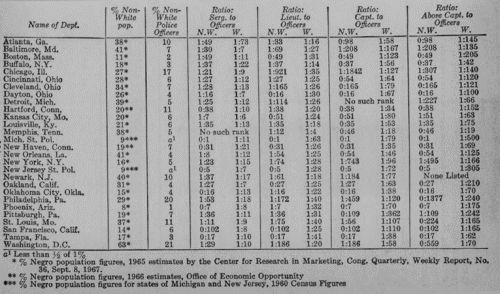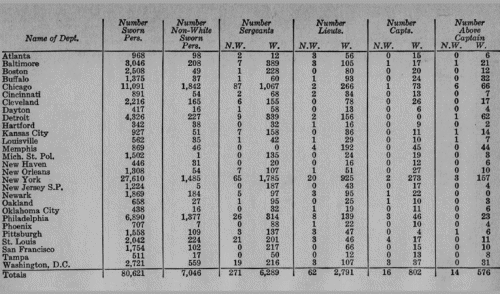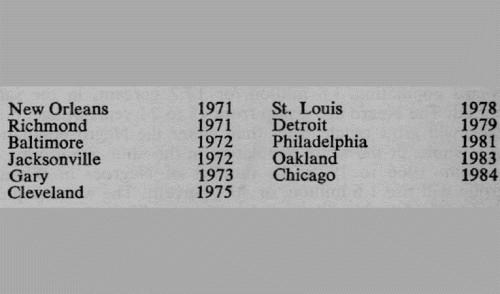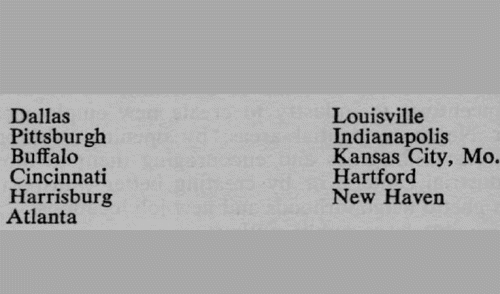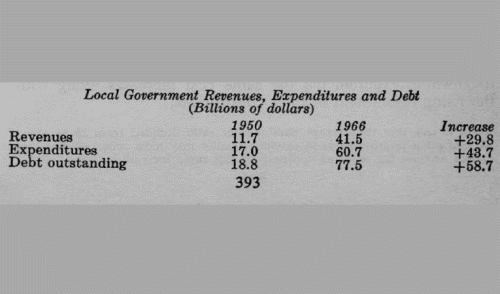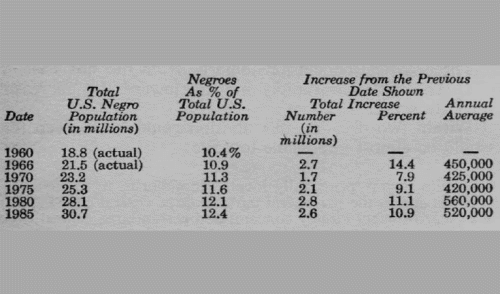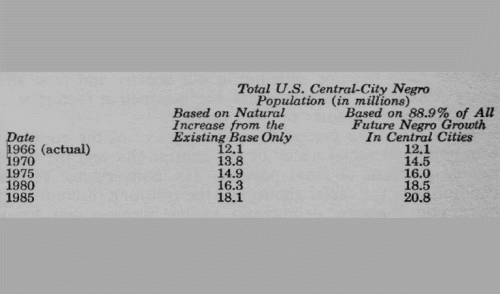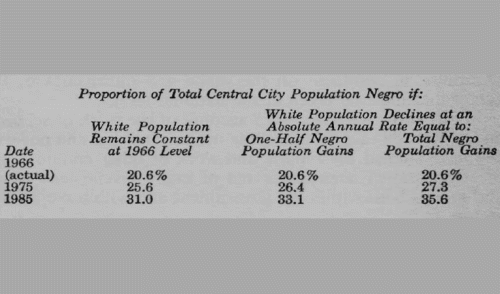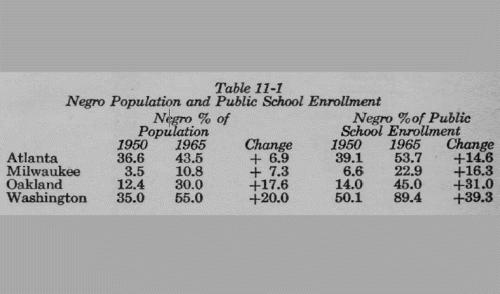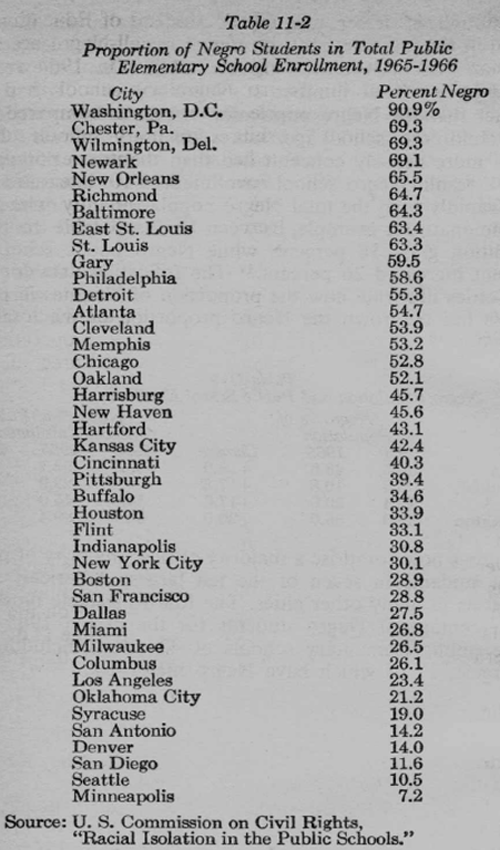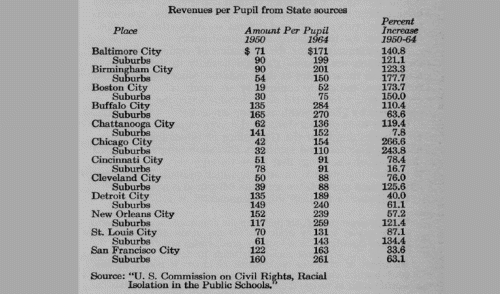Chapter 10: The Community Response
INTRODUCTION
The racial disorders of last summer in part reflect the failure of all levels of government -- federal and state as well as local -- to come to grips with the problems of our cities. The ghetto symbolizes the dilemma: a widening gap between human needs and public resources and a growing cynicism regarding the commitment of community institutions and leadership to meet these needs.
The problem has many dimensions -- financial, political and institutional. Almost all cities -- and particularly the central cities of the largest metropolitan regions -- are simply unable to meet the growing need for public services and facilities with traditional sources of municipal revenue. Many cities are structured politically so that great numbers of citizens -- particularly minority groups -- have little or no representation in the processes of government Finally, many cities lack both the will and the capacity to use effectively the resources that are available to them.
Instrumentalities of federal and state government often compound the problems. National policy expressed through a very large number of grant programs and institutions rarely exhibits a coherent and consistent perspective when viewed at the local level. State efforts, traditionally focused on rural areas, often fail to tie in effectively with either local or federal programs in urban areas.
Meanwhile, the decay of the central city continues-its revenue base eroded by the retreat of industry and white middle- class families to the suburbs, its budget and tax rate inflated by rising costs and increasing numbers of dependent citizens and its public plant schools, hospitals and correctional institutions deteriorated by age and long deferred maintenance.
Yet to most citizens, the decay remains largely invisible. Only their tax bills and the headlines about crime or "riots" suggest that something may be seriously wrong in the city.
There are, however, two groups of people that live constantly with the problem of the city: the public officials and the poor, particularly the residents of the racial ghetto. Their relationship is a key factor in the development of conditions underlying civil disorders.
Our investigations of the 1967 riot cities establishes that:
Virtually every major episode of urban violence in the summer of 1967 was foreshadowed by an accumulation of unresolved grievances by ghetto residents against local authorities (often, but not always, the police). So high was the resulting underlying tension, that routine and random events, tolerated or ignored under most circumstances (such as the raid on the "Blind Pig" in Detroit and the arrest of the cab driver in Newark) became the triggers of sudden violence.
Coinciding with this high level of dissatisfaction, confidence in the willingness and ability of local government to respond to Negro grievances was low. Evidence presented to this Commission in hearings, field reports and research analyses of the 1967 riot cities, establishes that a substantial number of Negroes were disturbed and angry about local governments' failures to solve their problems.
Several developments have converged to produce this volatile situation.
First, there is a widening gulf in communications between local government and the residents of the erupting ghettos of the city. As a result, ghetto residents develop a profound sense of isolation and alienation from the processes and programs of government. This lack of communication exists for all residents in our larger cities; it is, however, far more difficult to overcome for low income, less educated citizens who are disproportionately supported by and dependent upon programs administered by agencies of local government. Consequently, they are more often subject to real or imagined official misconduct ranging from abrasive contacts with public officials to arbitrary administrative actions.
Further, as a result of the long history of racial discrimination, grievances experienced by Negroes often take on personal and symbolic significance transcending the immediate consequences of the event. For example, inadequate sanitation services are viewed by many ghetto residents not merely as instances of poor public service but as manifestations of racial discrimination. This perception reinforces existing feelings of alienation and contributes to a heightened level of frustration and dissatisfaction, not only with the administrators of the sanitation department, but with all the representatives of local government. This is particularly true with respect to the police, who are the only public agents on duty in the ghetto 24 hours a day and who bear this burden of hostility for the less visible elements of the system.
The lack of communication and the absence of regular contacts with ghetto residents prevents city leaders from learning about problems and grievances as they develop. As a result, tensions which could have been dissipated if responded to promptly, mount unnecessarily and the potential for explosion grows inevitably. Once trouble erupts, public officials are frequently unable to fashion an effective response; they lack adequate information about the nature of the trouble and its causes and they lack rapport with local leaders who might be able to influence the community.
Second, many city governments are poorly organized to respond effectively to the needs of ghetto residents, even when these needs are made known to appropriate public officials. Most middle class city dwellers have limited contacts with local government. When contacts do occur they tend to concern relatively narrow and specific problems. Furthermore, middle-class citizens, although subject to many of the same frustrations and resentments in dealing with the public bureaucracy as ghetto residents, find it relatively easy to locate the appropriate agency for help and redress. If they fail to get satisfaction, they can call on a variety of remedies -- assistance of elected representatives, friends in government, a lawyer. In short, the middle-class city dweller has relatively fewer needs for public services and is reasonably well p0sitioned to move the system to his benefit.
Almost by definition, on the other hand, the typical ghetto resident has complicated social and economic problems which often require the services of a whole variety of government and private agencies. At the same time, he may be unable to break down his problems in ways which fit the complicated structure of government. Moreover, he is often unaware of his rights and opportunities as they exist under public programs and unable to develop the necessary guidance from either public or private sources.
Current trends in municipal administration have had the effect of reducing the capacity of local government to respond effectively to these problems. The pressures for administrative efficiency and cost-cutting have brought about the withdrawal of many of the operations of city government from direct contact with neighborhood and citizen. The introduction of a merit system and a professionalized civil service has made the cities far more businesslike, but it has also tended to depersonalize government and isolate it from the individual. The spreading of the ghetto and the rigid patterns of segregation within the central city have widened further the distance between Negro citizens and city hall. Red tape and administrative complexity have filled the vacuum created by the centralization of local government.
In most of the riot cities surveyed by the Commission, we found little or no meaningful coordination among city agencies either in responding to the needs of ghetto residents on an ongoing basis or in planning to head off disturbances. The consequences of this lack of coordination were particularly severe for the police. Despite the fact that they were being called upon increasingly to deal with tensions and citizen complaints having little, if anything, to do with police services, the police departments of many large cities were isolated from other city agencies, sometimes including the mayor and his staff. In these cities, the police were compelled to deal with ghetto residents angered over dirty streets, dilapidated housing, unfair commercial practices or inferior schools -- grievances which they had neither the responsibility for creating, nor the authority to redress.
Third, ghetto residents increasingly believe that they are excluded from the decision-making process which affects their lives and community. This feeling of exclusion, intensified by the bitter legacy of racial discrimination, has engendered a deep seated hostility toward the institutions of government. It has severely compromised the effectiveness of programs intended to provide improved services to ghetto residents.
In part, this is the lesson of Detroit and New Haven where well intentioned programs designed to respond to the needs of ghetto residents were not worked out and implemented sufficiently in cooperation with the intended beneficiaries. A report prepared for the Senate Subcommittee on Employment, Manpower and Poverty presented just prior to the riot in Detroit, found that:
Area residents ... complain almost continually that their demands for program changes are not heeded, that they have little voice in what goes on.... As much as the area residents are involved, listened to, and even heeded, ... it becomes fairly clear that the relationship is still one of superordinate-subordinate, rather than one of equals ... the procedures by which HRD [the Mayor's Committee for Human Resources Development. the Detroit Community Action Agency] operates by and large, admits the contributions of area residents only after programs have been written, after policies have already operated for a time or already been formulated, and to a large degree, only in formal and infrequent meetings rather than in day-today operations .... The meaningfulness of resident involvement is reduced by its after-the-fact nature and by relatively limited resources they have at their disposal. [1]
Mayor Alfonso J. Cervantes of St. Louis was even more explicit In testimony before this Commission, he stated that:
We have found that ghetto neighborhoods cannot be operated on from outside alone. The people within them should have a voice, and our experience has shown that it is often a voice that speaks with good sense, since the practical aspect of the needs of the ghetto people are so much clearer to the people there than they are to anyone else.
The political system, traditionally an important vehicle for minorities to participate effectively in decisions affecting the distribution of public resources, has not worked for the Negro as it has for other groups. Causes are not hard to find.
We have shown that the number of Negro officials in elected and appointed positions in the riot cities is minimal in proportion to the Negro population. The alienation of the Negro from the political process has been exacerbated by his racial and economic isolation.
Specifically, the needs of ghetto residents for social welfare and other public services have swelled dramatically at a time when increased affluence has diminished the need for such services by the rest of the urban population. By reducing disproportionately the economic disability of other portions of the population, particularly other ethnic urban minorities, this affluence has left the urban Negro few potential local allies with whom to make common cause for shared objectives. The development of political alliances, essential to effective participation of minority groups in the political process, has been further impaired by the polarization of the races, which on both sides has transformed economic considerations into racial issues.
Finally, these developments have coincided with the demise of the historic urban political machines and the growth of the "city manager" concept of government. While this tendency has produced major benefits in terms of honest and efficient administration, it has eliminated an important political link between city government and low-income residents.
These conditions have produced a vast and threatening disparity in perceptions of the intensity and validity of Negro dissatisfaction. Viewed from the perspective of the ghetto resident, city government appears distant and unconcerned, the possibility of effective change remote. As a result, tension rises perceptibly; the explosion comes as the climax to a progression of tension-generating incidents. To the city administration, unaware of this growing tension or unable to respond effectively to it, the outbreak of disorder comes as a shock.
No democratic society can long endure the existence within its major urban centers of a substantial number of citizens who feel deeply aggrieved as a group, yet lack confidence in the government to rectify perceived injustice and in their ability to bring about needed change.
We are aware that reforms in existing instruments of local government and their relationship to the ghetto population will mean little unless joined with sincere and comprehensive response to the severe social and economic needs of ghetto residents. Elsewhere in this Report we make specific recommendations with respect to employment, education, welfare, housing and other programs which we hope will meet some of these needs.
We believe, however, that there are measures which can and should be taken now; that they can be put to work without great cost and without delay; that they can be built upon in the future and that they will effectively reduce the level of grievance and tension as well as improve the responsiveness of local government to the needs of ghetto residents.
BASIC STRATEGY AND GOALS
To meet the needs identified above, we recommend pursuit of a comprehensive strategy, which would accomplish the following goals:
• Effective communication between ghetto residents and local government.
• Improved ability of local government to respond to the needs and problems of ghetto residents.
• Expanded opportunities for indigenous leadership to participate in shaping decisions and policies which affect their community.
• Increased accountability of public officials.
We recognize that not all of the programs proposed below to implement the foregoing goals can be instituted with the immediacy which the problem requires. Because the need for action at the local level, where government impinges directly upon the ghetto resident, is particularly urgent, we propose that our suggested programs be implemented in two phases. It is vital, however, that the first phase programs not be regarded or perceived as short term anti-riot efforts calculated to cool already inflamed situations. These programs will have little chance of succeeding unless they are part of a long-range commitment to action designed to eliminate the fundamental sources of grievance and tension.
PROGRAMS: FIRST PHASE ACTIONS
Establishment of Neighborhood Action Task Forces
To open channels of communication between government and ghetto residents, improve the capacity of the city administration to respond effectively to community needs and provide opportunity for meaningful citizen participation in decision-making, we recommend establishment of joint government-community Neighborhood Action Task Forces covering each neighborhood within the city which has a high proportion of low-income minority citizens. While the exact form of these groups will depend upon the size and needs of each municipality, the following basic features should be incorporated:
Composition: Each Task Force should include a key official in the mayor's office with direct and immediate access to the mayor, ranking city officials from the operating agencies servicing the ghetto community, elected leaders, representatives from the local business, labor, professional and church communities and neighborhood leaders, including representatives of community organizations of all orientations and youth leaders. Each Task Force would be headed by the mayor's representative. In the larger cities, each of these chairmen would sit as a member of a city-wide Urban Action Task Force.
Functions: The Neighborhood Action Task Forces should meet on a regular basis at a location accessible to ghetto residents. These meetings will afford an opportunity for ghetto leaders to communicate directly with the municipal administrators for their area to discuss problems and programs which affect the community. In effect, this device furnishes an interagency coordinating mechanism on the one hand and a "community cabinet" on the other.
Ghetto residents should be able to rely on the capacity of the Task Force to cut through the maze of red tape and to overcome bureaucratic barriers in order to make things -- collection of garbage, removal of abandoned cars, installation of lights in the park, establishment of playstreets -- happen. To accomplish this purpose, the participating city officials should be those with operational decision-making authority. Lesser staff or public relations personnel will not be able to provide the confrontation and interaction with the community representatives which is essential to the effective functioning of the Task Force. Moreover, there is grave danger that opening channels of communication without providing opportunities for obtaining relief will further estrange ghetto residents. If this is not to happen, the Task Force should have a meaningful and realistic capacity for securing redress of grievances. For the same reason, it is essential that the Task Force have the full and energetic support of the mayor and the city council.
The potential for responding effectively to community needs is not limited to available public resources. Acting through business, labor and church members and local Urban Coalitions which have already been formed, the Task Force will have a capacity to involve the resources of the private sector in meeting needs within the ghetto. Possibilities range from support of special summer youth programs (weekend trips, recreation events, camping programs) to provision of cultural and employment opportunities on a year-round basis.
The Neighborhood Action Task Force can playa significant role with respect to youth activities. One possibility involves the establishment of Youth Councils which would employ young street leaders (regardless of previous police records) to develop community programs for other alienated youth. These activities might include organizing and operating remedial libraries, neighborhood cleanup campaigns, police-community dialogues and sports competitions in their own neighborhoods.
Finally, the Task Force can make a major contribution to the prevention of civil disorders. If the Task Force has been successful in achieving the objectives stressed above, its members will have gained the confidence of a wide spectrum of ghetto residents. This will enable it to identify potentially explosive conditions and, working with the police, to take action to defuse the situation.
Similarly, the Task Force could have considerable effectiveness in handling threatening incidents identified by the police. To accomplish this objective, an early warning system could be instituted during the critical summer months. Operating on a 24-hour basis, such a system would have the capacity to receive and evaluate police reports of potentially serious incidents and to initiate an appropriate non-police response, utilizing community contacts and Task Force personnel. Any such operation must have the cooperation of the police, who will be in control of the overall disorder response. To avoid confusion and duplication of effort, the Task Force should have responsibility for coordinating the efforts of all agencies, other than police and fire, once a disturbance has occurred. An example will serve to illustrate how such a system might operate.
Following the slaying last summer of a Negro teen-ager by a Negro detective in the Bedford-Stuyvesant section of Brooklyn, New York, a rumor that the youth bad been shot by a white policeman and that the police were trying to suppress this information began to circulate through an already tense neighborhood. The situation became threatening. Yet, within an hour, three white members of the mayor's summer task force group were able to convince a group of black militants that the police version was true. Walking the streets that night and the next two evenings, they worked to dispel the rumor and to restore community stability.
In the larger cities, the Urban Action Task Force could have responsibility for coordinating the programs of various municipal agencies, concentrating their impact on poverty areas and planning for the more effective implementation of existing public efforts.
The Commission believes that the Task Force approach can do precisely what other forms of neighborhood organizations have not been able to do. It can connect the real needs and priorities of low-income residents with the energies and resources of both city government and the private sector. It can substantially improve the quality and timeliness of city services to these areas. It will fail unless all of the groups involved are prepared to deal fairly and openly with the problems of the community. But if it succeeds, it will not only produce improved services but help to generate a new sense of community, as well.
Establishment of Effective Grievance-Response Mechanisms
Effective implementation of the Neighborhood Action Task Forces will depend upon the continuing commitment of the city administration to its success. To ensure continuous attention to many of the sources of tension identified above, we recommend that formal mechanisms for the processing of grievances, many of which will relate to the performance of the city government, be established independent of the local administration.
We are convinced, on the record before this Commission, that the frustration reflected in the recent disorders results, in part at least, from the lack of accessible and visible means of establishing the merits of grievances against the agencies of local and state government, including but not limited to the police. Cities and states throughout the country now have under consideration various forms of grievance-response devices. While we are not prepared to specify the form which such a mechanism should take in any particular community, there are certain criteria which should be met. These include:
• Independence: This can be achieved by long term appointment of the administrator, subject to City Council removal. The grievance agency should be separate from operating municipal agencies.
• Adequate staff and funding: Exact costs will vary depending on the size and needs of the city's population. It is most important that the agency have adequate funds and staff to discharge its responsibilities.
• Comprehensive coverage of grievances against public agencies and authorities: General jurisdiction will facilitate access by grievants. Moreover, unlike specialized, complaint agencies, such as civilian review boards, all agencies would be brought equally under public scrutiny. This should facilitate its acceptance by public officials.
• Power to receive complaints, hold hearings, subpoena witnesses, make public recommendations for remedial action to local authorities and, in cases involving violation of law, bring suit. These powers are the minimum necessary to the effective operation of the grievance mechanism. As we envision it, the agency's principal power derives from• its authority to investigate and make public findings and recommendations. It should, of course, have a conciliation process whereby complaints could be resolved without full investigation and processing.
• Accessibility: In large cities, access may require setting up neighborhood offices in ghetto areas. In others, local resident aides could be empowered to receive complaints. It should be possible to file a grievance orally or in writing. If forms are used, they should be easily understood and widely available.
• Participation in grievance process: Grievants should be given full opportunity to take part in all proceedings and to be represented by counsel. They should receive prompt advice of action taken, and results of investigations should be made public.
Expanded Legal Service to the Poor
Among the most intense grievances underlying the riots of the summer 1967 were those which derived from conflicts between ghetto residents .and private parties, principally the white landlord and merchant. Though the legal obstacles are considerable, resourceful and imaginative use of available legal processes could contribute significantly to the alleviation of tensions resulting from these and other conflicts. Moreover, through the adversary process which is at the heart of our judicial system, litigants are afforded meaningful opportunity to influence events which affect them and their community. However, effective utilization of the courts requires legal assistance, a resource seldom available to the poor.
Litigation is not the only need which ghetto residents have for legal service. Participation in the grievance procedures suggested above may well require legal assistance. More importantly, ghetto residents have need of effective advocacy of their interests and concerns in a variety of other contexts, from representation before welfare agencies and other institutions of government to advocacy before planning boards and commissions concerned with the formulation of development plans. Again, professional representation can provide substantial benefits in terms of overcoming the ghetto resident's alienation from the institutions of government by implicating him in its processes. Although lawyers function in precisely this fashion for the middle-class clients, they are too often not available to the impoverished ghetto resident.
The Legal Services Program administered by the Office of Economic Opportunity has made a good beginning in providing legal assistance to the poor. Its present level of effort should be substantially expanded through increased private and public funding. In addition, the participation of law schools should be increased through development of programs whereby advanced students can provide legal assistance as a regular part of their professional training. In all of these efforts, the local bar bears major responsibility for leadership and support.
Assistance for Mayors and City Councils
In the chapters that follow we direct attention to broad strategies and programs of national action. Yet the capacity of the Federal Government to affect local problems depends to a great extent on the capacity of city government to respond competently to federal program initiatives.
In the face of the bewildering proliferation of both community demands and local, state and federal programs, mayors and city councils need to create new mechanisms to aid in decision making, program planning and coordination. At this time, however, no assistance is available to develop these new and critically necessary institutional capabilities or to support the required research, consultants, staff or other vital components of administrative or legislative competence.
The Commission recommends, therefore, that both the state and federal governments provide financial assistance to cities for these purposes as a regular part of all urban program funding.
Hearings on Ghetto Problems and Enactment of Appropriate Local Legislation
Many of the grievances identified in our study of the conditions underlying civil disorders can be redressed only through legislative action. Accordingly, we recommend that the legislative body of each city with a substantial minority population hold., as soon as possible, a series of hearings on ghetto problems. In large cities, these hearings could well be held in the ghetto itself to facilitate full citizen participation.
In addition to establishing a foundation for needed legislative measures, these hearings would constitute a visible demonstration of governmental concern for the problems of ghetto residents. They would also provide a most useful means of bridging the communications gap, contributing to an improved understanding in the white community about the conditions of ghetto life.
Expanded Employment by City Government of Ghetto Residents
We strongly recommend that local government undertake a concerted effort to provide substantial employment opportunities for ghetto residents. Local governments now employ 6.4 million people full-time, most of whom live in urban areas; they comprise one of the fastest growing segments of the economy. This offers an opportunity of the greatest significance for local government to respond to one of the most critical needs of ghetto residents and, at the same time, to decrease the distance between city hall and the ghetto by deliberate employment, training and upgrading of Negroes.
To accomplish this goal, we recommend that municipal authorities review applicable civil service policies and job standards and take prompt action to remove arbitrary barriers to employment of ghetto residents. Re-evaluation is particularly necessary with respect to requirements relating to employment qualification tests and police records. Leadership by city government in this vital area is of urgent priority, not only because of the important public employment potential, but also to stimulate private employers to take similar action.
SECOND PHASE ACTIONS
Establishment of Neighborhood City Halls
The Neighborhood Action Task Force concept provides a basis on which lasting structures can be erected. The principal change required in order to transform the official component of the Task Force into a permanent instrument of local government involves the establishment of offices in the neighborhoods served. Depending on the size and composition of the neighborhood, the permanent staff should include an assistant mayor, representatives of the municipal agencies, the city councilman's staff and other institutions and groups included in the Task. Force. This facility would function, in effect, as a "Neighborhood City Hall."
The Neighborhood City Hall would accomplish several interrelated objectives. It would contribute to the improvement of public services by providing an effective channel for low-income citizens to communicate their needs and problems to the appropriate public officials and by increasing the ability of local government to respond in a coordinated and timely fashion. It would serve as the eyes and ears of the mayor and council and furnish an informal forum for complaints and grievances. It would make information about government programs and services available to ghetto residents, enabling them to make more effective use of such programs and services and making clear the limitation on the availability of all such programs and services. It would expand opportunities for meaningful community access to and involvement in the planning and implementation of policy affecting their neighborhood. Most important, the Neighborhood City Hall, building on the Task Force approach, affords a significant opportunity to accomplish the democratic goal of making government closer and more accountable to the citizen.
Development of Multi-Service Centers
Frequently, services vital to the ghetto resident -- job placement and location, health care, legal assistance -- are inaccessible because they are located at considerable distance from the ghetto, a distance often made greater by the lack of efficient public transportation. This problem is compounded by the fact that many key service institutions are fragmented, requiring those seeking assistance to pursue it at various locations scattered throughout a large urban area.
To meet this need, the Office of Economic Opportunity has funded over 700 multi-service centers in ghetto areas throughout the country since 1964. Many of these have been small store-front operations housing OEO-funded services. Some, as in Detroit, have had a fairly wide range of services and have served a large number of families.
The principal problem has been that most centers have not been comprehensive enough. They rarely include traditional city and state agency services. Many relevant federal programs 3!e seldom located in the same center. Manpower and education programs from HEW and the Labor Department, for example, have been housed in separate centers without adequate consolidation or coordination either geographically or programmatically.
The resulting proliferation led the President to call upon the Department of Housing and Urban Development to establish comprehensive "one stop service centers." The experience thus far indicates the need for more effective coordination of federal programs at the national and regional levels. Legislation may be required to simplify grant procedures and assure such coordination.
Each center should have enough neighborhood workers to reach out into the homes of needy people who are not able to seek help. To assure that the service centers are relevant to the needs and styles of the neighborhood, ghetto residents should be trained and employed at all levels. This purpose can well be served through establishment and involvement of Community Service Center Councils to establish overall policy.
We recommend increased federal funding for comprehensive centers, and implementation of the policy guidelines proposed above.
Improved Political Representation
It is beyond the scope of this Report to consider in detail the many problems presented by the existing distribution of political power within city governments. But it is plain that the Negro ghetto resident feels deeply that he is not represented fairly and adequately under the arrangements which prevail in . many cities. This condition strikes at major democratic values.
To meet this problem, city government and the majority community should revitalize the political system to encourage fuller participation by all segments of the community. Whether this requires adoption of anyone system of representation, we are not prepared to say. But it is clear that at-large representation, currently the practice in many American cities, does not give members of the minority community a feeling of involvement or stake in city government. Further, this form of representation dilutes the normal political impact of pressures generated by a particular neighborhood or district.
Negro representation and participation in the formal structure of government can also be furthered by a concerted effort to appoint Negroes to significant policy positions in city government.
More Effective Community Participation
One of the most difficult and controversial problems we have encountered relates to ghetto demands for "self-determination" or "community control." To a limited extent, this concept was made a matter of national policy in the Economic Opportunity Act of 1964 which specified that community action programs should be developed, conducted and administered with "maximum feasible participation" of the residents of the areas and members of the groups served.
In the three years since the beginning of the war on poverty, the effort to put "maximum feasible participation" into effect has met with both success and failure. One measure of its success can be seen in the extent to which the demand for participation, even control, over a variety of programs affecting the ghetto has spilled over into the most traditional areas, such as public school administration.
But the demands made often seem intransigent and the time required for negotiation with residents extravagant. The pulling and hauling of different factions competing for control within the ghetto community sometimes makes it difficult to mount any program. Moreover, it is often easier to organize groups to oppose, complain, demonstrate and boycott than to develop and run programs.
Yet, the demand for a community voice represents a marked and desirable gain over the apathy that existed before. Despite its problems, we believe that meaningful community participation and a substantial measure of involvement in program development is an essential strategy for city government The democratic values which it advances -- providing a stake in the social system, improving the accountability of public officials -- as well as the pragmatic benefits which it provides far outweigh these costs.
The essential question which city leadership must face is the ultimate goal of community participation. In this sense, community involvement is directly related to the strategy of decentralization, for with the support of the city, neighborhood groups may become an effective force for carrying on a variety of functions-such as physical renewal and redevelopment -- which can be highly disruptive when imposed by outside authority.
If these principles are accomplished, then the choice of mechanisms will depend upon the needs of the particular community and the structure of the local government. We have described earlier in this section opportunities for meaningful community participation in the processes of government. Additional and diverse instrumentalities such as community neighborhood school boards, community planning boards, tenants' councils, youth councils, advisory committees and consumer trade organizations offer further ways of providing institutional channels for effective citizen participation in public decision-making. The crucial issue, however, is whether city government is willing to legitimate these organizations by dealing with them on a regular basis with respect to matters within their c0mpetence. We believe that such an approach offers substantial promise of improving the relationship between local government and ghetto residents.
The involvement of the ghetto community in the planning and operation of development programs need not be confined to the public arena. There is great potential in private community development corporations which can emerge from a combined public-private sponsorship and perform mixed functions for the community, including sponsorship of locally owned businesses.
A most promising approach is the neighborhood membership corporation, the first of which was established in Columbus, Ohio, in 1965 -- the East Central Citizens Organization (ECCO), under an OEO grant. Functioning as a town meeting, its members include all of the residents of a defined ghetto neighborhood (8,150 people). Its activities encompass daycare centers, credit unions, legal and medical services, newspapers, restaurants and business enterprises.
Both money and manpower will be needed from government, foundations and private business to create and assist these corporations and other new community institutions. Technical and professional support will be required. The opportunity that they offer to develop stable community ,leadership structures and constructive involvement should not be allowed to fail for lack of such support.
CONCLUSION
Finally, there remains the issue of leadership. Now, as never before, the American city has need for the personal qualities of strong democratic leadership. Given the difficulties and delays involved in administrative reorganization or institutional change, the best hope for the city in the short run lies in this powerful instrument. In most cities the mayor will have the prime responsibility.
It is in large part his role now to create a sense of commitment and concern for the problems of the ghetto community and to set the tone for the entire relationship between the institutions of city government and all the citizenry.
Part of the task is to interpret the problems of the ghetto community to the citizenry at large and to generate channels of communication between Negro and white leadership outside of government. Only if all the institutions of the community -- those outside of government as well as those inside the structure -- are implicated in the problems of the ghetto, can the alienation and distrust of disadvantaged citizens be overcome.
This is now the decisive role for the urban mayor. As leader and mediator, he must involve all those groups -- employers, news media, unions, financial institutions and others-which only together can bridge the chasm now separating the racial ghetto from the community. His goal, in effect, must be to develop a new working concept of democracy within the city.
In this effort, state government has a vital role to play. It must equip city leadership with the jurisdictional tools to deal with its problems. It must provide a fuller measure of financial and other resources to urban areas. Most importantly, state leadership is in a unique position to focus the interests and growing resources, political as well as financial, of the suburbs on the physical, social, and cultural environment of the central cities. The crisis confronting city government today cannot be met without regional cooperation. This cooperation can take many forms -- metropolitan government, regional planning, joint endeavors. It must be a principal goal, perhaps the overriding concern, of leadership at the state level to fashion a lasting and mutually productive relationship between city and suburban areas.
_______________
Notes:
1. Examination of War on Poverty, Staff and Consultants Reports, prepared by Center for Urban Studies. University of Chicago, for the Subcommittee on Employment, Manpower and Poverty, Senate Committee on Labor and Public Welfare, 90th Cong., 1st Sess., (Sept. 1967), pp. 1721 ff.

